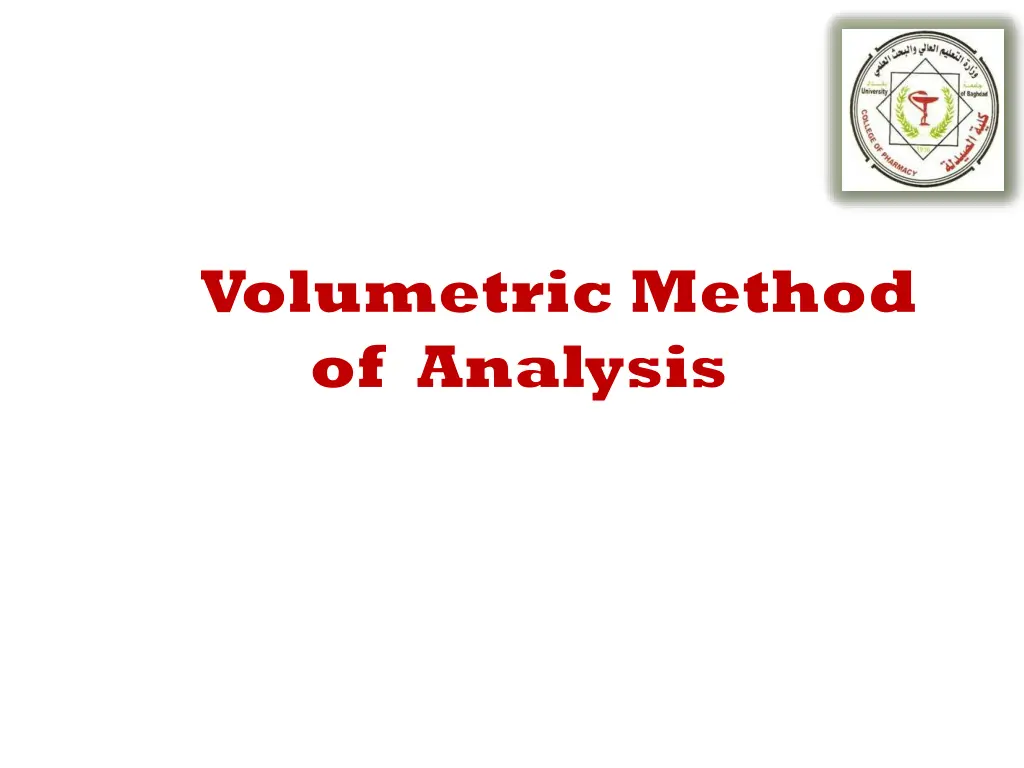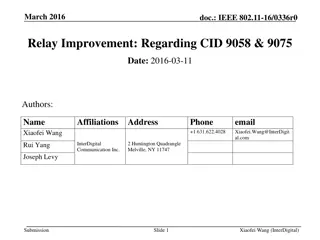
Understanding Volumetric Analysis in Chemistry
Explore the principles of volumetric analysis, including primary and secondary standards, indicators, and concentration calculations. Learn about normality, equivalence point, and the role of indicators in titrations. Discover the importance of using high-purity primary standards for accurate analytical methods.
Uploaded on | 1 Views
Download Presentation

Please find below an Image/Link to download the presentation.
The content on the website is provided AS IS for your information and personal use only. It may not be sold, licensed, or shared on other websites without obtaining consent from the author. If you encounter any issues during the download, it is possible that the publisher has removed the file from their server.
You are allowed to download the files provided on this website for personal or commercial use, subject to the condition that they are used lawfully. All files are the property of their respective owners.
The content on the website is provided AS IS for your information and personal use only. It may not be sold, licensed, or shared on other websites without obtaining consent from the author.
E N D
Presentation Transcript
Volumetric M Volumetric Method of Analysis of Analysis ethod
Primary Primary Standard Standard solution solution Secondary Secondary
Primary standard: Primary standard: It' It's a s a highly highly purified chemical compound that serves as purified chemical compound that serves as a reference material in titrations and in other analytical a reference material in titrations and in other analytical methods. methods. Requirements for a primary standard are the following: 1 1. . It must be of the highest purity. It must be of the highest purity. 2 2. . It should be stable and not attacked by atmosphere It should be stable and not attacked by atmosphere, , ( ( Atmospheric stability ). Atmospheric stability ). 3 3. . It should not be hygroscopic. It should not be hygroscopic. 4 4. . It should have high It should have high equivalence, ( equivalence, ( large molar mass ), to to minimize weighing errors minimize weighing errors. . 5 5. . It It should be should be available available and not too expensive and not too expensive. . large molar mass ),
Very few compounds meet or even approach these criteria, and only a limited number of primary standard substances are available commercially. As a consequence, less pure compounds must sometimes be used in place of a primary standard. The purity of such a secondary standard must be established by careful analysis. Secondary standard: It is a compound whose purity has been determined by chemical analysis. The secondary standard serves as the work - ing standard material for titrations and for many other analysis.
Indicator: An indicator is a chemical compound that exhibits a change in color as a result of concentration changes occurring near the equivalence point. Equivalence point: It's the point in a titration when the amount of the added standard reagent is chemically equivalent to the amount of analyte. End point: It is the point in a titration when a physical changes associated with the equivalence point can be observed.
Volumetric Calculations: The concentration of a solution can be expressed in several ways: Concentration of solution Concentration of solution Normality Molarity Formality
1. Normality: It is the number of equivalents of solute contained in one liter of solution. Equivalent mass, called equivalent weight in the older literature, of an acid or base which participates in a neutralization reaction, is the mass that supplies or reacts with one mole of protons in a particular reaction. For example, the equivalent mass of H2SO4is one half of it's molar mass.
2. Molarity: It is the number of gram molar mass or the number of moles of solute in one liter of solution.
3. Formality: It is the number of gram formula mass in one liter of solution.
Acid Acid Base Titrations. Base Titrations. ( ( Neutralization Titrations ). Neutralization Titrations ). Oxidation Oxidation Reduction Titrations. Reduction Titrations. ( ( Redox Titrations ). Redox Titrations ). Complexometric Complexometric Titrations. Titrations. Precipitation Titrations. Precipitation Titrations.
Neutralization Titrations Neutralization Titrations Principles: Neutralization titrations are widely used to determine the amounts of acids and bases. The std. solutions used in neutralization titrations are always strong acids or strong bases because these substances react more completely with an analyte than do weak acids & bases, and as a result, they produce sharper end points. Weak acids & bases are never used as standard reagents because they react incompletely with analytes.
Acid/Base Indicators: They are generally complex organic cpd.s of high molecular weight dissolved in water or other solvents where it's color depends on the pH of the medium. An acid/base indicator , is a weak organic acid or a weak organic base whose undisso - ciated form differs in color from it's conjugate base or it's conjugate acid form. For example For example, the behavior of an acid-type indicator, HIn, is described by the equilibrium HIn + H2O In- + H3O+ Acid color Base color
The equilibrium for a base - type indicator, In, is In + H2O InH + + OH - Base color Transition range of an indicator: It's the pH range over which change in color of an indicator takes place. Acid color Color in Acidic medium Color in Basic medium Acid/Base indicator Transition range Phenolphthalein ( ph-ph ) 8.3 - 10 Colorless Pink Methyl Orange ( M.O ) 3.1 4.4 Orange - Pink Yellow Methyl Red ( M.R ) 4.2 6.3 Red Yellow
* Practical Analytical Chemistry , University of Baghdad , College of Pharmacy, Department of Pharmaceutical Chemistry, 2010. * A. H. Beckett, Practical Pharmaceutical Chemistry, Quantitative Analysis, 1962. * Douglas A. Skoog, Donald M. West , F. James Holler, Stanley R. Crouch, Fundamentals of Analytical Chemistry, 9thedition , 2014. * Vogel , Arthur , Vogel's Textbook of Quantitative Chemical Analysis , 6th edition.

